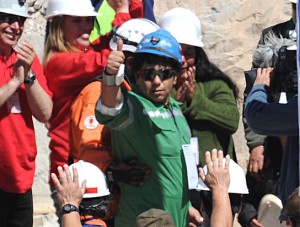There are rare moments when a small group of people capture the world’s attention. Compelling circumstances and human need touch our collective hearts and stir our empathy as the world becomes invested in their well-being.
On August 5th 2010, there was a massive cave-in at the San Jose copper mine in the remote Chilean desert. The collapse left 33 miners unaccounted for and presumed dead.
 Rescue workers drilled into the collapsed mine for over two weeks, finding no signs of life. After 17 days, workers heard tapping on one of the drills and when they brought it to the surface there was a note attached. The note said: “We are well in the refuge, the 33.”
Rescue workers drilled into the collapsed mine for over two weeks, finding no signs of life. After 17 days, workers heard tapping on one of the drills and when they brought it to the surface there was a note attached. The note said: “We are well in the refuge, the 33.”
The story of disaster had now become a story of hope as the world’s attention turned to the trapped miners.
Rescue workers were able to drill small passageways to the miners to send them food and water, but the task of drilling through a half-mile of rock to evacuate them would not be easy. Mining companies throughout the world scrambled to send the best drilling equipment and professional engineering expertise.
Instead of implementing a single plan to evacuate the miners, rescue workers decided to implement three different drilling plans simultaneously.
Plan A – Drill directly into the miner’s refuge using a mining drill
Plan B – Enlarge an existing hole that descended to the mine at an angle
Plan C – Use an oil drill that drills larger, deeper holes than mining drills at another angle
All three drilling efforts proceeded until October 9th when the plan B drill broke through to the miners. On October 13th a rescue capsule was lowered through the newly expanded hole and one-by-one, all 33 miners were brought to the surface.
The Many Approaches of Six Sigma
 A Six Sigma project is rarely the same kind of high-stakes life-or-death situation, but it does have several elements in common with the Chilean mine workers’ rescue. First, there was a demand for tangible results, not just progress on paper. Second, just as the rescue drilling operation used multiple plans to reach the miners, Six Sigma uses multiple tools for reducing inefficiency, variation and waste to optimize process performance:
A Six Sigma project is rarely the same kind of high-stakes life-or-death situation, but it does have several elements in common with the Chilean mine workers’ rescue. First, there was a demand for tangible results, not just progress on paper. Second, just as the rescue drilling operation used multiple plans to reach the miners, Six Sigma uses multiple tools for reducing inefficiency, variation and waste to optimize process performance:
SIPOC – The (Suppliers Inputs Process Outputs Customers) chart gives the team a high-level view of the process and provides details about each contributing group.
CTQ (critical to quality) tree – A CTQ Tree identifies, organizes and displays parts of a process according to areas of critical importance to help the project team search for causes.
Simulation – This tool finds defects, errors, bottlenecks and variance in the process. It simulates the flow of work and material through the process to measure efficiency.
Fishbone Diagram – Displays the sources of variation in a process and identifies the key elements that contribute most significantly to the problem.
Failure Mode Effects Analysis (FMEA) – Evaluates a process or product to determine its potential for failure, the ability to detect failure and the impact of failure.
Rescue workers didn’t rely on just one drilling plan to save the trapped miners. They used several different plans. Some worked better than others and one finally provided the breakthrough. The same is true for Six Sigma. If a project team puts its trust in one or two tools to identify the problem and optimize the process, it could miss out on important information and take longer to complete the project.
Six Sigma offers a multitude of tools to help optimize a process. Some will be more useful than others, and the larger the variety of Six Sigma tools that the team uses, the better it will understand the problem and the faster it will identify the solution.
